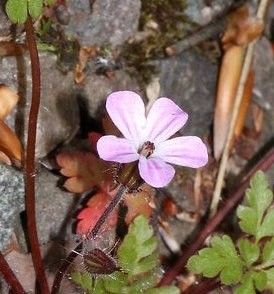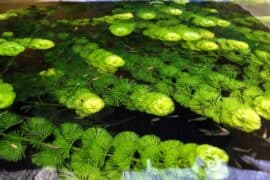Australian cranesbill
(Geranium solanderi)

Description
Geranium solanderi (common names - native geranium, Australian cranesbill, Austral cranesbill, Cut-leaf cranesbill, native carrot, and hairy geranium) is a species of plant in the family Geraniaceae. It is native to Australia (New South Wales, Queensland, Victoria, South Australia, Western Australia, and Tasmania), and to New Zealand. It was first described in 1800 by Daniel Solander as Geranium pilosum, from a specimen found in New Zealand. However, the name was illegal (having already been used in 1787 by Antonio José Cavanilles) and it was renamed in 1965 by Roger Charles Carolin, with the species epithet, solanderi, honouring Solander. Geranium solanderi is a perennial, spreading herb with the ends growing upward. The stemas are up 50 cm long, and coarsely hairy. The taproot is swollen and often like a turnip. The flowers are paired (rarely solitary) on an inflorescence stald (peduncle) which is 1–4 cm long, with each flower on a flower stalk (pedicel) which is 2.5–5 cm long. The sepals are 5–9 mm long, and the pink petals are 5–12 mm long, pink and often have yellowish veins. The anthers are yellow. The fruits are 12–25 mm long and the seeds are black. In New Zealand, in both 2004 and 2009 it was declared "Not threatened", but in 2012, under the New Zealand Threat Classification System it was declared "At Risk - Declining", with the qualifiers SO (safe overseas) and DP (data poor), and this status was reaffirmed in 2017. Geranium is a genus of 422 species of annual, biennial, and perennial plants that are commonly known as geraniums or cranesbills. They are found throughout the temperate regions of the world and the mountains of the tropics, but mostly in the eastern part of the Mediterranean region. The palmately cleft leaves are broadly circular in form. The flowers have five petals and are coloured white, pink, purple or blue, often with distinctive veining. Geraniums will grow in any soil as long as it is not waterlogged. Propagation is by semiripe cuttings in summer, by seed, or by division in autumn or spring. Geraniums are eaten by the larvae of some Lepidoptera species including brown-tail, ghost moth, and mouse moth. At least several species of Geranium are gynodioecious. The species Geranium viscosissimum (sticky geranium) is considered to be protocarnivorous.
Taxonomic tree:







